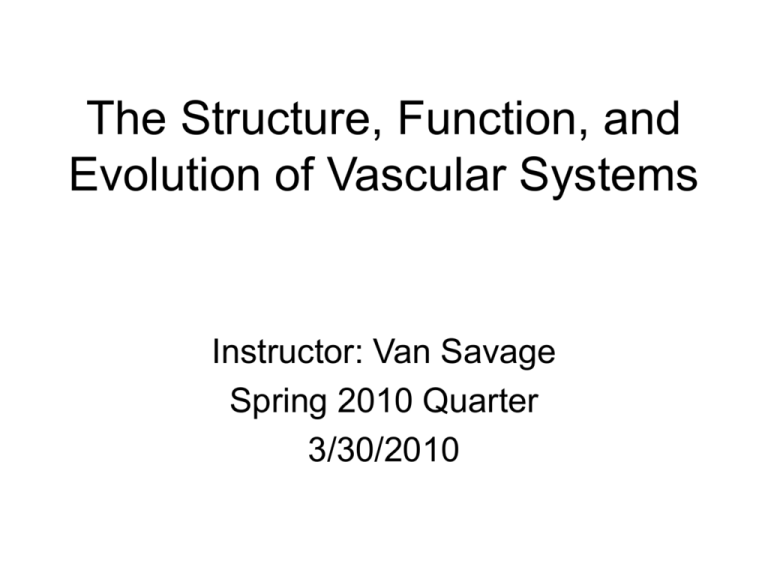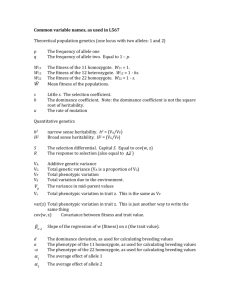p 1
advertisement

The Structure, Function, and Evolution of Vascular Systems Instructor: Van Savage Spring 2010 Quarter 3/30/2010 Course Themes • Learn mathematical methods for studying biomedical and biological systems, including interactions (epistasis and among species), topology and dynamics of gene interaction networks and food webs, tumor initiation and growth, antibiotic resistance, and much more • Evolutionary theory is key to all of these and is a central way to understand dynamics of biological systems • Applied Math methods from asymptotics that are useful for all types of models, including evolution, predator prey, topology, informatics, scaling, etc. Textbook • Evolutionary Theory: Mathematical and Conceptual Foundations by Sean Rice • Advanced Mathematical Methods for Scientists and Engineers by Carl Bender and Steven Orszag • Several recent papers published in high-profile journals. I will give you these in advance. Students will take turns presenting the research paper and leading discussion. Everyone will do at least one paper. • Back and forth between texts and paper which is the way science is really done. What do I expect from you? • To come to class because I will cover material from multiple places that is not all in your book or papers and because you will learn more if you actively participate • To ask questions when you do not understand and give feedback • To turn in 4 homework sets (40%) • To do a class project with paper and presentation (40%) • In class presentations of papers (20%) • To work hard What backgrounds do you have? What research do you do? What do you hope to get out of the course? What topics would you most like to see covered? Crash Course in Evolutionary Theory (See Chapter 1 of Sean Rice book) What is fitness and what does it describe? Ability of an entity to survive and propagate forward in time. It is inherently a dynamic (time evolving property). Can assign fitness to 1. 2. 3. 4. 5. 6. 7. 8. Individuals Genes Phenotypes Behaviors Strategies (economic, cultural, games, etc) Tumor cells and tumor treatment Antibiotic resistance Language Types of definitions Absolute Fitness-number of surviving offspring Relative Fitness-scaled version of absolute fitness. Typically scaled relative to wild type (when looking at mutations) or population average (net advantage or disadvantage) or the maximum, making the peak fitness equal to 1. As with most of science, ratios and differences drive nature, not absolute number because those depend on units, which are just a manmade abstraction and not part of nature. Evolution in particular is about relative advantage or disadvantage. Absolute fitness is useful because it connects to ecology and population theory. Hardy-Weinberg model Definitions 1. Loci is location of allele on genome 2. Allele is version of gene at that loci Assumptions 1. Two alleles exist A1 and A2 2. Population is infinitely large so choosing an allele does not affect probability of choosing that same allele again (no conditional probabilities) 3. Random mating means for each new offspring we can pick any two alleles at random Hardy-Weinberg model t ………. A1 A1 A1 A2 A2 A2 ………. A1 A1 ………. A1 A2 ………. p1 is frequency of allele A1 and p2 is frequency of allele A2 Bag of two different colored marbles A1 A1 t+1 ………. A1 A2 A1 A2 A1 A1 A2 A2 A2 A2 A1 A1 ………. ………. A1 A1 A1 A2 ………. ………. A1 A2 ………. Hardy-Weinberg model At generation t+1, the frequencies are Frequency of A1 A1 Frequency of =p12 Frequency of A1 A2 =2p1p2 Note that these are the different terms of Also, note that ( p1 p2 ) 2 p1 p2 1 ( p1 p2 ) 2 A2 A2 =p22 Fitness and population growth For a population to grow, it must be finite, and thus not match Hardy-Weinberg assumptions Nt = Number of individuals at time t wij is fitness of genotype with phenotype AiAj N t 1 p N t w11 2 p(1 p)N t w12 (1 p) N t w 22 2 2 wN t This is now in the form of population growth equations w p w11 2 p(1 p)w12 (1 p) w 22 2 2 How does fitness change with allele frequency? dw * * 2(w1 w 2 ) dp marginal fitness is expected number of descendants of a given allele w pw11 (1 p)w12 * 1 w pw12 (1 p)w 22 * 2 Evolution of allele frequency and Wright’s equations p(1 p) d ln w p(1 p) d(rG) pt 2 dp 2 dp Conclusions 1. Increases in direction of slope of fitness function 2. Allele frequency climbs peak until maximal fitness and this derivative or slope is zero 3. Peak occurs when marginal fitness for A1 and A2 are equal, implying relative fitness of heterozygote 4. Prefactor is actually a variance, so strength of selection depends on variance. No variance implies no selection. w p What does variance mean here? Where is it zero? What is slope? Where is it zero? Two peaks here. Can this happen in current version of our model? How do we maintain variance? Mutation and migration What is typical effect of a mutation? Wild Type fitness=1 (relative fitness) Hetero. Mutant fitness=1-hs Deleterious double mutant=1-s Genetic Load= 1 w sp 2 2 phs(1 p) Next class we will move onto mutation, finite-size populations, additive genetic variance, and interactions between loci and genes and possibly touch on drift and coalescence. Read Chapter 1 of Rice’s book. I will put a copy in Biomath office or outside my office. Starting soon, probably next week, we will use these ideas to discuss papers on the distribution of epistatic interactions, modeling epistasis, the evolution of sex, and the evolution of antibiotic resistance.






